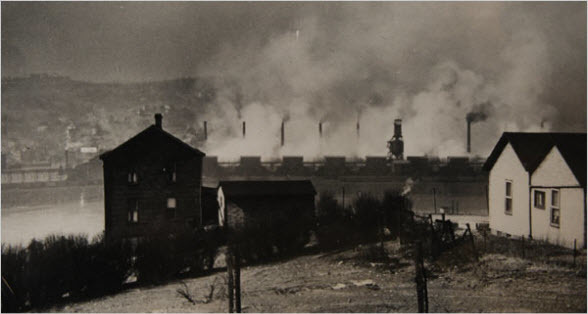Air Mail!: News About NY Air Quality - October
The New York State Department of Environmental Conservation sent this bulletin on 10/18/2018 05:02 PM EDT |
| DEC Delivers - Information to keep you connected and informed from the NYS Department of Environmental Conservation |
| Share or view as a web page || Update preferences or unsubscribe |
|
Banner photo credit: CathyJo Rogers, “Snowy Mountain, Lake Pleasant, NY.” The Smog That Choked Donora
Photo caption: Smoke coming from metal manufacturers near residential homes in Donora, PA. Photo credit: Sean D. Hamill. (2008, Nov 1) Unveiling a Museum, a Pennsylvania Town Remembers the Smog That Killed 20. New York Times “If you chewed the air hard enough you could swallow it,” said a resident from Donora, Pennsylvania looking back at the 1948 Donora Smog event. On October 27, 1948, Donora was engulfed by smog caused by emissions from the American Steel & Wire Company and Donora Zinc Works. The smog became trapped in the valley by a temperature inversion which occurs when cold air becomes trapped by warmer air above, especially within valleys. It inhibits turbulence and rising air that normally disperses pollutants. Due to low visibility, evacuation was nearly impossible during the Donora smog event, which lead to 26 people dying and around half of the residents becoming ill. After five days of smog, a rain storm blew in and dispersed the pollution. This event was an important contributor to the creation of the first air pollution-related regulations in the U.S., resulting in the passage of the 1955 Air Pollution Control Act. This act gave funding to states and local governments for research to determine the source and scope of air pollution. Air pollution research began in 1957 in New York State with a small unit of staff in the Department of Health. Air pollution research and control was moved to the NYS Department of Environmental Conservation in 1970, where it still is today.
Photo Caption: An example of a temperature inversion as steam rises in the Hudson River Valley during the early morning hours near Albany, NY. Photo credit: Randi Walker. World Food DayOctober 16, 2018 is designated as World Food Day, which spreads global awareness of the need to ensure food security and nutritious diets for everyone. Air pollutants can cause damage to plants and ultimately reduce crop yields. The most common sign of air pollution damage is browning, yellowing or whitening of leaves in small patches. Crops at high risk of damage from air pollution are soy, wheat, corn and rice, all of which are staple foods for most of the world.
Another way to reduce air pollution is to buy your produce locally so that less air pollution is given off to transport the food to supermarkets. Locally grown produce can often be found at your regular grocery store, farmers’ markets or by purchasing a community-supported agriculture (CSA) share. Purchasing locally grown food is a valuable way to contribute to your community and improve the air quality of everyone. Think of ways to green up your meals by eating healthy, using energy wisely, and keeping our air clean and easy to breathe. The Burning Question: Fall LeavesDid you know that it is illegal to burn leaves in New York State? Burning vegetation, other lawn debris, and trash releases pollution in the form of smoke and soot. Smoke contains particulate matter and harmful chemicals like carbon monoxide which pose a risk to your health, your pets, neighbors, wildlife and the environment. Burning leaves and other lawn debris also increases the likelihood of wildfires. Fires are regulated in New York State. Lawn debris, including leaves, is not approved fuel for open fires and should not be put into household trash. Instead of burning your leaves, you can:
See our website for more tips on what to do with fall leaves. Comment Periods:
Upcoming Events:
Stay Informed about Your Air QualityNew York's ozone season runs from April through September. DEC publishes ground-level ozone forecasts during ozone season, and particulate matter pollution forecasts year-round using a scale called the Air Quality Index (AQI). DEC sends out an air quality alert when there is a high AQI value, which indicates polluted air. Individuals with pre-existing respiratory or cardiovascular conditions, and people who exercise outdoors should take caution during an air quality alert. Find out if an Air Quality Alert is in effect by calling the toll-free Ozone Hotline: 1-800-535-1345. The AQI can be accessed in two ways:
We would like to know what you think. Please send your Air Mail! questions or comments to us at DAR.web@dec.ny.gov. |

 This Month’s Topics:
This Month’s Topics:
 The 1948 Donora Smog event brought national attention to the detrimental effects of air pollution and made both federal and state governments take action to reduce air pollution. It is important to continue to reduce pollution to protect ourselves, the environment and future generations to come. For more information on the Donora Smog of 1948, visit the
The 1948 Donora Smog event brought national attention to the detrimental effects of air pollution and made both federal and state governments take action to reduce air pollution. It is important to continue to reduce pollution to protect ourselves, the environment and future generations to come. For more information on the Donora Smog of 1948, visit the  There are many different factors that affect crop success, but air pollution is one we have the power to control. Since many air pollutants are produced by burning fossil fuels, we can all help by using energy efficient devices and getting our energy from
There are many different factors that affect crop success, but air pollution is one we have the power to control. Since many air pollutants are produced by burning fossil fuels, we can all help by using energy efficient devices and getting our energy from